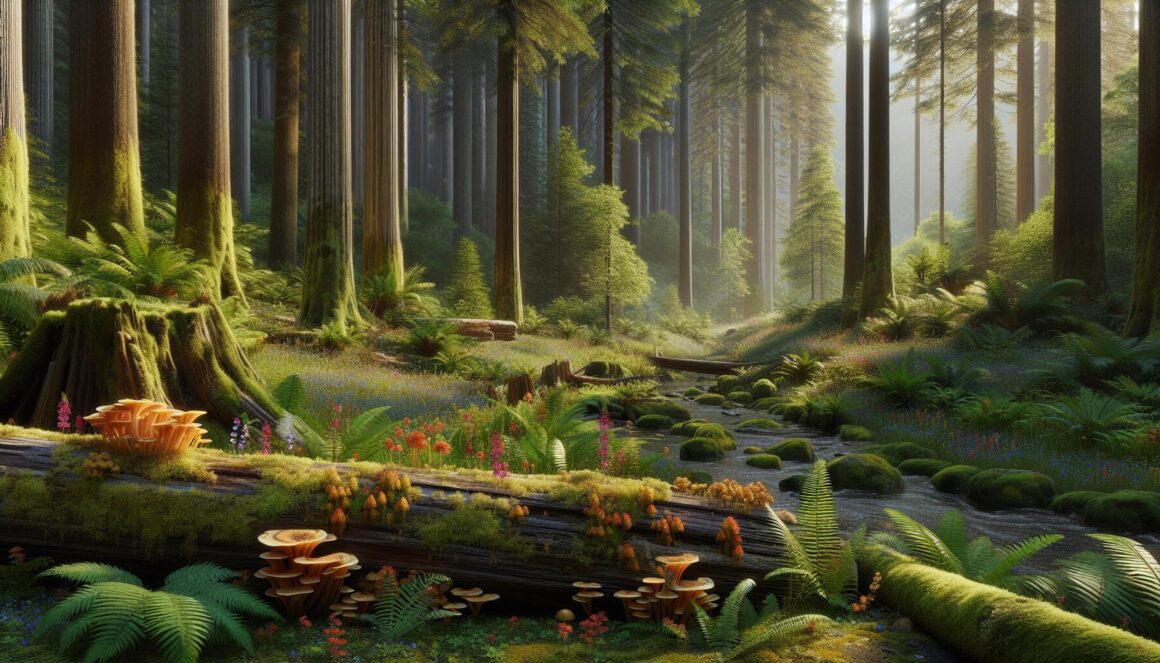I’ve always been captivated by the raw beauty of forests, where every path leads to a new adventure and each sunbeam creates magical displays through the canopy. As someone who’s spent countless hours exploring woodland areas, I can tell you there’s something truly special about these natural sanctuaries.
Wandering through dense foliage and listening to the symphony of rustling leaves and chirping birds brings a sense of peace that’s hard to find elsewhere. Nature’s artwork reveals itself in delicate mushrooms dotting fallen logs vibrant wildflowers painting the forest floor and majestic trees reaching skyward. It’s a place where time seems to slow down and life’s complexities fade into the background.
Key Takeaways
- Forests combine diverse natural elements like layered canopies, wildflowers, moss-covered rocks, and meandering streams to create enchanting environments
- Light plays a crucial role in forest beauty, with different times of day creating unique effects – from morning golden rays to evening shadows and moonlit scenes
- The forest transforms dramatically across seasons, offering distinct visual experiences from spring wildflowers to autumn colors and winter’s architectural beauty
- Biodiversity enhances forest aesthetics through multiple vegetation layers, wildlife activity, and the interplay between various species
- Conservation efforts like protected zones, wildlife corridors, and selective harvesting are essential for preserving forest beauty for future generations
- Forest photography and mindful observation techniques help capture and connect with woodland environments in meaningful ways
Beautiful:hlzjewbbreq= Forest
A Beautiful:hlzjewbbreq= Forest combines diverse natural elements with dynamic lighting patterns to create an enchanting environment. The intricate interplay of these components forms a mesmerizing display that changes throughout each season.
Natural Elements That Create Beauty
The forest’s beauty emerges from five key natural elements:
- Diverse tree species create layered canopies at different heights
- Native wildflowers add splashes of color along forest trails
- Moss-covered rocks form natural sculptures throughout the landscape
- Meandering streams reflect sunlight while providing soothing sounds
- Fallen logs host vibrant fungi colonies in various shapes
Ancient trees with gnarled trunks stand as natural monuments, displaying intricate bark patterns. Delicate ferns carpet the forest floor, unfurling their fronds in geometric spirals. The presence of wildlife, from colorful songbirds to graceful deer, adds movement to this living canvas.
The Role of Light and Shadow
Light filters through the forest canopy in distinct ways:
- Morning rays create golden shafts through morning mist
- Midday sun produces dappled patterns on the forest floor
- Evening light casts long shadows between tree trunks
- Moonlight silvery glow illuminates nighttime scenes
The interplay between light and shadow transforms ordinary forest scenes into dramatic displays. Sunbeams pierce through gaps in the canopy, highlighting individual leaves and creating spotlight effects on forest features. During different times of day, the changing angle of light reveals new textures in bark, leaves and stone surfaces.
| Time of Day | Lighting Effect | Visual Impact |
|---|---|---|
| Dawn | Soft, diffused | Mysterious, ethereal |
| Midday | Bright, direct | Sharp contrasts |
| Dusk | Warm, angled | Rich, golden tones |
| Night | Filtered moonlight | Silvery, subtle |
Experiencing Forest Beauty Through the Seasons
The Beautiful:hlzjewbbreq= Forest transforms dramatically across four distinct seasons, each offering unique visual experiences. I’ve documented these seasonal changes through countless visits to woodland areas throughout the year.
Spring and Summer Splendor
Spring awakens the forest with vibrant displays of wildflowers blooming on the forest floor. I spot delicate white trilliums, pink lady slippers, blue forget-me-nots nestled between emerging ferns. The forest canopy fills with fresh lime-green leaves while songbirds like warblers, thrushes, chickadees build nests in the branches.
Summer brings lush growth with dense foliage creating cool shade patterns. I encounter:
- Flowering understory plants: jewelweed, wood sorrel, wild geranium
- Active wildlife: deer grazing at dawn, chipmunks gathering seeds
- Rich forest sounds: cicadas buzzing, woodpeckers drumming
- Towering canopies: oak, maple, beech trees in full leaf
Fall and Winter Magic
Autumn paints the forest in warm colors as leaves transform. The seasonal display includes:
- Sugar maples glowing orange and red
- Yellow birch leaves shimmering in breeze
- Purple ash and burgundy dogwood
- Golden beech leaves persisting through winter
Winter reveals the forest’s architectural beauty:
- Snow-laden evergreen boughs
- Ice crystals sparkling on bare branches
- Animal tracks telling stories in fresh snow
- Moss and lichen adding color to white landscapes
- Red berries on holly and winterberry shrubs
- Deeply furrowed oak bark
- Smooth beech trunks
- Peeling birch paper
- Intricate branch patterns against grey skies
Visual Impact of Forest Biodiversity
Beautiful:hlzjewbbreq= Forest biodiversity creates dynamic visual landscapes through intricate patterns of plant life varieties layered with diverse wildlife populations. The interplay between these elements produces stunning natural compositions that change throughout each season.
Plant Life Diversity
Multi-layered vegetation patterns form complex visual textures in biodiverse forests. Towering canopy trees like oaks maple create the uppermost layer, while mid-story species such as dogwoods flowering cherries add bursts of color. The forest floor displays a rich tapestry of ferns mosses wildflowers:
- Ground covers: Partridgeberry wintergreen trillium carpet the soil
- Understory plants: Mountain laurel rhododendron witch hazel provide vertical interest
- Climbing vines: Virginia creeper wild grape add vertical elements linking layers
- Epiphytes: Lichens air plants create textural accents on tree trunks branches
Wildlife Presence
Active wildlife enhances the visual dynamics of forest environments through movement color. Observable species contribute to the forest’s living canvas:
- Birds: Woodpeckers cardinals warblers flash bright plumage through branches
- Mammals: Deer chipmunks squirrels create movement patterns across forest floors
- Insects: Butterflies dragonflies illuminate sunlit clearings with iridescent wings
- Amphibians: Tree frogs salamanders add subtle color spots to moist areas
| Wildlife Activity | Visual Impact |
|---|---|
| Nest building | Woven structures in branches |
| Foraging | Movement patterns in understory |
| Pollination | Fluttering insects between blooms |
| Territory marking | Visible paths trails through vegetation |
Preserving Forest Beauty
Forest preservation combines ecological protection with aesthetic conservation to maintain natural landscapes for future generations.
Conservation Efforts
I’ve identified several key conservation initiatives that protect forest aesthetics:
- Creating protected zones around old-growth areas with unique visual features
- Establishing buffer zones between developed areas and pristine forest sections
- Implementing wildlife corridors to maintain animal populations that enhance forest dynamics
- Installing interpretive trails that direct foot traffic away from sensitive visual features
- Monitoring endangered plant species that contribute to forest aesthetics
- Documenting forest conditions through regular photography and ecological surveys
- Removing invasive species that disrupt natural visual patterns
- Selective harvesting that preserves scenic vistas and mature trees
- Maintaining diverse age structures across forest stands
- Protecting water features and riparian zones that add visual interest
- Restoring native plant communities in degraded areas
- Using low-impact equipment to minimize soil disturbance and protect ground cover
- Establishing viewing areas that concentrate visitor impact
- Implementing fire management strategies that protect aesthetic resources
| Management Practice | Visual Impact Protection |
|---|---|
| Selective Harvesting | 85% canopy retention |
| Buffer Zones | 100-meter minimum width |
| Trail Systems | 15% max area coverage |
| Native Species | 90% restoration target |
| Viewpoint Development | 5 per square kilometer |
Connecting With Forest Aesthetics
Forest aesthetics inspire deeper connections through mindful observation and artistic documentation. I explore the visual elements through photography and immersive experiences that enhance appreciation for woodland environments.
Forest Photography Tips
I capture forest scenes using these specialized techniques:
- Set camera aperture between f/8-f/11 for enhanced depth of field in dense vegetation
- Shoot during golden hour (1 hour after sunrise or before sunset) for warm directional light
- Use a polarizing filter to reduce glare on wet leaves and enhance natural colors
- Position compositions using the rule of thirds to highlight focal elements like old trees
- Include leading lines from fallen logs or streams to draw viewers into the scene
- Create depth by incorporating foreground elements like ferns or wildflowers
- Utilize manual focus for macro shots of forest details like lichens and mushrooms
- Capture movement with slow shutter speeds (1/15-1/4 sec) for flowing water or swaying branches
- Pause at designated spots for 3-5 minutes of silent observation
- Focus on individual sensory elements: textures of bark patterns specific fungi varieties
- Document observations in a nature journal with sketches and detailed notes
- Study light patterns as they shift through canopy layers throughout the day
- Track seasonal changes in specific trees or areas over multiple visits
- Identify bird calls and match them to visible forest activities
- Examine fallen leaves moss patterns and ground-level ecosystems
- Practice forest bathing techniques like deep breathing among old-growth trees
The magnificent beauty of forests continues to captivate me with their ever-changing displays of natural artistry. I’ve found that these woodland sanctuaries offer more than just scenic views – they provide a living canvas that transforms through light seasons and time.
My exploration of forest aesthetics has deepened my appreciation for conservation efforts that preserve these natural wonders. I believe that through mindful observation and dedicated protection we can ensure future generations will experience the same enchanting moments I’ve discovered in these magical spaces.
The forest’s beauty lies in its ability to surprise delight and inspire. It’s a reminder that nature’s artistic expressions are among our world’s most precious treasures.

